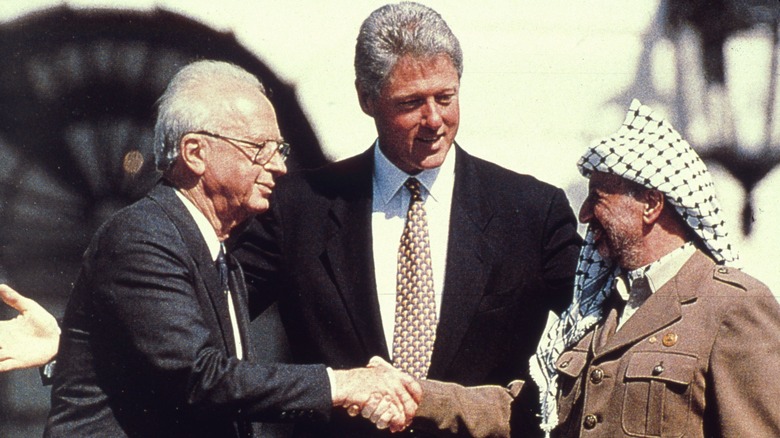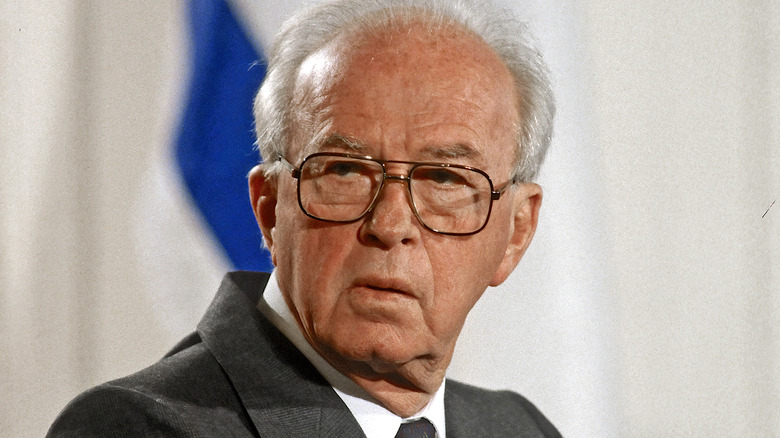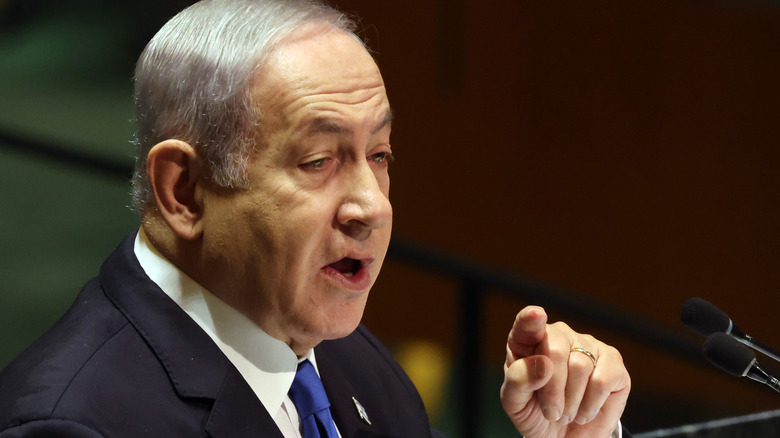What Is The Two-State Solution?
At a 1993 summit held in Oslo, Norway, Israeli Prime Minister Yitzhak Rabin and Palestine Liberation Organization (PLO) Negotiator Mahmoud Abbas agreed on the so-called two-state solution by signing the Oslo I Accord. The plan was part of the Oslo Accords, two agreements between Israel and the PLO that established the Palestinian Authority (PA), which presided over parts of the Gaza Strip and the West Bank and allowed for limited self-government. The second was signed in 1995, and the goal of the accords was to quell decades of violence between Palestinians and Israeli Jews — but the idea was in trouble before it even began, as Jewish and Arab extremist violence derailed the ongoing negotiations.
Most broadly, the two-state proposal formalized at a signing celebration hosted by the Clinton White House (seen above) called for two sovereign Palestinian and Israeli states to coexist side-by-side. Since then, changes in both Israeli and Palestinian leadership, diplomatic errors from the U.S., and ongoing extremist violence from both Jews and Palestinians have stalled progress. As of 2023, 30 years after the first Oslo Accord was signed, the two-state solution had not yet come to pass. In 2016, The New York Times outlined four roadblocks to the two-state solution: agreed-upon borders between Palestinians and Israel, the question of who controls Jerusalem, Palestinian refugees returning to the area, and foreign military occupation in the West Bank.
After the October 2023 surprise attack by Hamas on Israel and Israel's declaration of war, former White House Middle East Envoy in the Trump Administration Jason Greenblatt wrote for CNN that the proposed two-state solution — already tenuous as of 2016 — could be done for good.
1995 Rabin assassination
Right away, the two-state solution proposed in the 1993 Oslo I Accord — officially known as the Declaration of Principles on Interim Self-Government Arrangements — was unpopular with more extreme factions in both Israel and Palestinian territories. Just one year later, Jewish radical Baruch Goldstein shot and killed 29 Palestinians and wounded more than 100 others on the Jewish holiday Purim at the Cave of Patriarchs, a Muslim and Jewish holy site where hundreds of Muslims had gathered for Ramadan. Goldstein was killed at the scene, The Jerusalem Post reported. After that, the Palestinian terrorist group Hamas — among others — began launching a series of suicide bombings in Israel, as listed by the Embassy of Israel.
The most significant setback for the implementation of the two-state solution, however, was perhaps the 1995 assassination of Israeli Prime Minister Yitzhak Rabin (pictured) by Jewish extremists opposed to the objectives of the Oslo Accords. Israeli Prime Minister Benjamin Netanyahu, who was elected in 1996, told PBS Frontline that once in office, "I looked at [the Oslo Accords] before the elections and I said I would honor it under two conditions: one, that [then Palestinian leader Yasir] Arafat honor it; ... the second was that I would reduce the dangers in Oslo within the agreement — reduce the withdrawals, reduce the price that Israel would have to pay."
Netanyahu left office the first time in 1999 — he returned in 2009, was ousted again in 2021, and returned in 2022. As of 2023 he was still in office. His first successor, Ehud Barak, among other Israeli prime ministers over the years, was more and less supportive of the Oslo Accords. The implementation process, however, has never fully recovered.
Palestinian resistance
The fact that the two-state solution has foundered can not just be blamed on the Israelis, however. Among other examples, in 2000, amid the Second Intifada — a Palestinian uprising — violence erupted after future Israeli Prime Minister Ariel Sharon visited the West Bank, the Gaza Strip, and the Old City of Jerusalem. More than 1,000 Israelis died, and thousands more were injured, according to the Anti-Defamation League. One year earlier, in 2000, then-Israeli Prime Minister Ehud Barak and Palestinian leader Yasir Arafat (pictured) met at Camp David, hosted again by then-U.S. President Bill Clinton with mixed results.
In 2020, Al Jazeera reported that at that time, Palestinians had grown frustrated with Israel's perceived lack of progress in honoring the Oslo Accords, which led to a contested agreement that Israeli borders would withdraw to their pre-1967 position — before the Six-Day War. Also in 2020, former Palestinian advisor at the Oslo negotiations, Diana Buttu, told Al Jazeera that between 1993 and 2000, "We saw that the number of settlers doubled from 200,000 to 400,000. You can see that what was happening on the ground was designed to ensure that there wasn't going to be an independent Palestinian state."
Meanwhile, Hani al-Masri — director-general of Masarat, the Palestinian Center for Policy Research and Strategic Studies — told Al Jazeera, "The main reason behind the Intifada was that Israeli leaders wanted to punish Arafat and the Palestinians to force them to accept the Israeli solutions that are similar to the status quo of occupation. They wanted to force the Palestinians' consciousness to accept what Israel wants."
The two-state solution: 2007 to 2023
Despite stop-and-start peace talks along the way, by 2007 leadership changes on both the Palestinian and Israeli sides led to the dissolution of the Palestinian Authority (PA), leaving Hamas unrepresented. The terrorist group had done particularly well in previous PA legislative elections. In 2009, Benjamin Netanyahu (above) again became Israeli Prime Minister, and disagreements continued over Israeli settlements in the West Bank, among other issues. The Trump administration tried to revive negotiations in the so-called "Deal of the Century," but a series of strategic decisions — namely, designating Jerusalem as Israel's capital — dismayed Palestinians. Despite the Biden administration's restoration of Palestinian aid, discontinued under Trump, the future of the two-state solution was uncertain.
In 2023, just before the war between Israel and Hamas broke out, Jonathan Panikoff, director of the Atlantic Council's Scowcroft Middle East Security Initiative wrote for Just Security, "Thirty years Oslo, Israelis and Palestinians are farther apart on an agreement than ever before. Many believe a two-state solution is no longer feasible and have suggested alternatives, but none seem viable." One potential solution, according to Panikoff, could be a "Switzerland-like confederation," but that's a rare form of government, which he called unrealistic for the complex situation between Israel and Palestinian territories.
According to Panikoff, "A one-state-two-system approach would do little to assure Israelis or Palestinians of lasting stability and peace; in the best example of it, China and Hong Kong, the latter's independent status has largely evaporated in recent years. So, the only realistic path for a lasting peace between Israelis and Palestinians remains a two-state solution."



